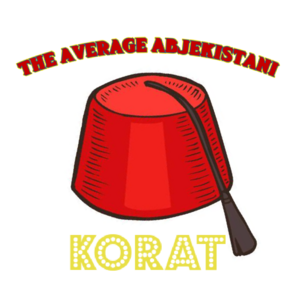People's Republic of Abjekistan (PRA): Difference between revisions
(added fashion) |
No edit summary |
||
| Line 13: | Line 13: | ||
Abjekhs love active and entertaining music, such as Bouzoukis, Kasatchoks and and traditional Yadakk music. The most popular dances are group dances, like the Koshandan line dance [https://www.youtube.com/watch?v=T4chpyTIE5Q&ab_channel=%D0%93%D0%BE%D1%81%D1%83%D0%B4%D0%B0%D1%80%D1%81%D1%82%D0%B2%D0%B5%D0%BD%D0%BD%D1%8B%D0%B9%D0%B0%D0%BA%D0%B0%D0%B4%D0%B5%D0%BC%D0%B8%D1%87%D0%B5%D1%81%D0%BA%D0%B8%D0%B9%D0%B0%D0%BD%D1%81%D0%B0%D0%BC%D0%B1%D0%BB%D1%8C%D0%BD%D0%B0%D1%80%D0%BE%D0%B4%D0%BD%D0%BE%D0%B3%D0%BE%D1%82%D0%B0%D0%BD%D1%86%D0%B0%D0%B8%D0%BC%D0%B5%D0%BD%D0%B8%D0%98%D0%B3%D0%BE%D1%80%D1%8F%D0%9C%D0%BE%D0%B8%D1%81%D0%B5%D0%B5%D0%B2%D0%B0], which originates from the massive Thuadian immigration wave in the 1880s, and the Abjekh kick dance. | Abjekhs love active and entertaining music, such as Bouzoukis, Kasatchoks and and traditional Yadakk music. The most popular dances are group dances, like the Koshandan line dance [https://www.youtube.com/watch?v=T4chpyTIE5Q&ab_channel=%D0%93%D0%BE%D1%81%D1%83%D0%B4%D0%B0%D1%80%D1%81%D1%82%D0%B2%D0%B5%D0%BD%D0%BD%D1%8B%D0%B9%D0%B0%D0%BA%D0%B0%D0%B4%D0%B5%D0%BC%D0%B8%D1%87%D0%B5%D1%81%D0%BA%D0%B8%D0%B9%D0%B0%D0%BD%D1%81%D0%B0%D0%BC%D0%B1%D0%BB%D1%8C%D0%BD%D0%B0%D1%80%D0%BE%D0%B4%D0%BD%D0%BE%D0%B3%D0%BE%D1%82%D0%B0%D0%BD%D1%86%D0%B0%D0%B8%D0%BC%D0%B5%D0%BD%D0%B8%D0%98%D0%B3%D0%BE%D1%80%D1%8F%D0%9C%D0%BE%D0%B8%D1%81%D0%B5%D0%B5%D0%B2%D0%B0], which originates from the massive Thuadian immigration wave in the 1880s, and the Abjekh kick dance. | ||
===Fashion=== | ===Fashion=== | ||
The traditional Abjekh clothing may vary according to the regions, but the Abjekh outfit constitutes of a burgundy fez, a White Tchekeska, colored baggy pants and high boots for men. Women often wear the Perankh, a colorful dress decorated with golden flowers. | The traditional Abjekh clothing may vary according to the regions, but the Abjekh outfit constitutes of a burgundy fez, a White Tchekeska, colored baggy pants and high boots for men. Women often wear the Perankh, a colorful dress decorated with golden flowers. | ||
===Cuisine=== | ===Cuisine=== | ||
===Medias=== | ===Medias=== | ||
[[File:Korat, the average Abjekistani.png|thumb|right|Thumbnail of the 24th season of Korat]] | |||
The region of Koshanda, the Abjekistan capital, is recognized for its soap operas, musicals and humoristic programs. The most popular is certainly Korat, the average Abjekistani. Korat is a weekly humoristic television show recounting the hectic life of Korat Belmuth, a citizen of the small city of Sirmak, located in the eastern Cheburek plains. | |||
==Industry== | |||
===Automotive=== | |||
Revision as of 02:02, 10 January 2021
Overview
The People's Republic of Abjekistan is a fledgling, safe nation, renowned for its frequent executions, irreverence towards religion, and punitive income tax rates. The quiet, industrious population of 6 million Abjekistanians are fiercely patriotic and enjoy great social equality; they tend to view other, more capitalist countries as somewhat immoral and corrupt.
The large, socially-minded government juggles the competing demands of Welfare, Law & Order, and Healthcare. The average income tax rate is 53.7%, and even higher for the wealthy.
The developing Abjekistanian economy, worth 167 billion Puzhaks a year, is led by the Tourism industry, with major contributions from Retail, Automobile Manufacturing, and Uranium Mining. State-owned companies are common. Average income is 27,834 Puzhaks, and distributed extremely evenly, with little difference between the richest and poorest citizens.
Scientists regularly clone human beings for research purposes, TV shows must meet strict ethnicity quotas, the death penalty has been reintroduced, and professionals are ready to retire by the time they receive permission to use their credentials. Crime, especially youth-related, is totally unknown, thanks to a well-funded police force and progressive social policies in education and welfare. Abjekistan's national animal is the Caucasian Red deer.
Culture
Music[1]
Abjekhs love active and entertaining music, such as Bouzoukis, Kasatchoks and and traditional Yadakk music. The most popular dances are group dances, like the Koshandan line dance [2], which originates from the massive Thuadian immigration wave in the 1880s, and the Abjekh kick dance.
Fashion
The traditional Abjekh clothing may vary according to the regions, but the Abjekh outfit constitutes of a burgundy fez, a White Tchekeska, colored baggy pants and high boots for men. Women often wear the Perankh, a colorful dress decorated with golden flowers.
Cuisine
Medias
The region of Koshanda, the Abjekistan capital, is recognized for its soap operas, musicals and humoristic programs. The most popular is certainly Korat, the average Abjekistani. Korat is a weekly humoristic television show recounting the hectic life of Korat Belmuth, a citizen of the small city of Sirmak, located in the eastern Cheburek plains.

